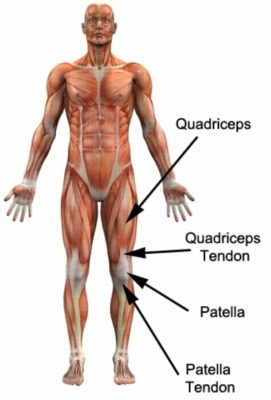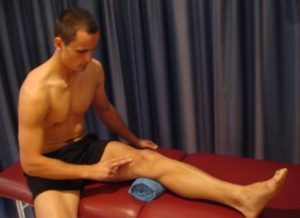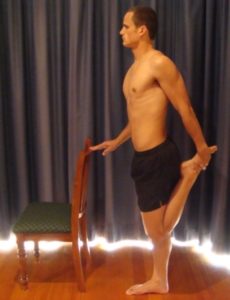Quadriceps Tendonitis
Updated:
(Also known as Quadriceps Tendinopathy, Quadriceps Tendinitis)
N.B. Although research suggests that ‘quadriceps tendinopathy’ is the more appropriate term to describe overuse injuries to the quadriceps tendon, we will use the term ‘quadriceps tendonitis’ in this document as it is more widely known.
What is quadriceps tendonitis?
Quadriceps tendonitis is a condition characterized by tissue damage and inflammation to the quadriceps tendon. This occurs at the quadriceps’ attachment to the top of the knee cap causing pain in the front of the knee just above the knee cap.
The quadriceps muscle originates from the pelvis and thigh bone (femur) and inserts into the top of the knee cap (patella) which in turn attaches to the top of the tibia (shin bone) via the patella tendon (figure 1).

The quadriceps is responsible for straightening the knee during activity and controlling the bend of the knee during weight bearing activity. It is particularly active during sprinting, jumping, hopping, squatting or kicking activities. During contraction of the quadriceps, tension is placed through the quadriceps tendon. When this tension is excessive due to too much repetition or high force, damage to the quadriceps tendon may occur. Quadriceps tendonitis is a condition whereby there is damage to the quadriceps tendon with subsequent degeneration and inflammation.
Although this condition can occur at any age, it is more common in the older athlete.
Causes of quadriceps tendonitis
Quadriceps tendonitis most commonly occurs due to repetitive or prolonged activities placing strain on the quadriceps tendon. This typically occurs due to repetitive running, jumping, hopping, squatting or kicking activities. It is also particularly common in sports requiring frequent acceleration and deceleration or repetitive jumping (such as basketball or netball).
Occasionally, patients may develop this condition suddenly due to a high force going through the quadricep tendon beyond what it can withstand. This may occur during rapid acceleration whilst running, when landing from a height or due to a direct blow to the quadriceps tendon.
Signs and symptoms of quadriceps tendonitis
Patients with quadriceps tendonitis typically experience pain that develops gradually at the front of the knee just above the knee cap. In less severe cases, patients may only experience an ache or stiffness in the knee that increases with rest following activities requiring strong or repetitive contraction of the quadriceps muscle. These activities typically include running, jumping, hopping, squatting or kicking. The pain associated with this condition may also warm up (or feel better) with activity in the initial stages of the condition.
As the condition progresses, patients may experience symptoms that increase during activity and affect performance. Occasionally, local swelling and a feeling of knee weakness may also be present particularly when attempting to accelerate whilst running or attempting to perform a squat. Other symptoms may include pain on firmly touching the quadriceps tendon (figure 1) and in some cases pain or a limp may be present when walking (particularly up hills or on uneven surfaces). Pain or stiffness may also be experienced upon stretching the quadriceps (i.e. taking your heel to your backside in standing).
Diagnosis of quadriceps tendonitis
A thorough subjective and objective examination from a physiotherapist is usually sufficient to diagnose quadriceps tendonitis. Occasionally, further investigations such as an Ultrasound, X-ray, MRI or CT scan may be required to assist with diagnosis and assess the severity of the condition.
Treatment for quadriceps tendonitis
Most cases of quadriceps tendonitis settle with appropriate physiotherapy. The success rate of treatment is largely dictated by patient compliance. One of the key components of treatment is that the patient rests sufficiently from any activity that increases their pain until they are symptom free. Activities which place large amounts of stress on the quadriceps tendon should also be minimized, these include: running (especially up or down hills, or, on uneven surfaces), jumping, hopping, squatting and kicking. Rest from aggravating activities allows the body to begin the healing process in the absence of further tissue damage. Once the patient can perform these activities pain free, a gradual return to these activities is indicated provided there is no increase in symptoms.
Ignoring symptoms or adopting a ‘no pain, no gain’ attitude is likely to lead to the condition becoming chronic. Immediate, appropriate treatment in all patients is essential to ensure a speedy recovery. Once the condition is chronic, healing slows significantly resulting in markedly increased recovery times and an increased likelihood of future recurrence.
Patients with quadriceps tendonitis should follow the R.I.C.E. Regime in the initial phase of injury. The R.I.C.E regime is beneficial in the first 72 hours following injury or when inflammatory signs are present (i.e. morning pain, night pain or pain with rest). The R.I.C.E. regime involves resting from aggravating activities, regular icing, the use of a compression bandage and keeping the affected leg elevated. Anti-inflammatory medication may also hasten the healing process by reducing the pain and swelling associated with inflammation.
Manual “hands-on” therapy from the physiotherapist such as massage, trigger point releases, joint mobilisation, dry needling, stretches and electrotherapy can also assist with hastening healing and improving flexibility and function in patients with quadriceps tendonitis.
Patients with this condition should perform pain free flexibility and strengthening exercises as part of their rehabilitation to ensure an optimal outcome. The treating physiotherapist can advise which exercises are most appropriate for the patient and when they should be commenced. Typically, the rehabilitation program will focus on stretches for the quadriceps muscles and strengthening exercises for the quadriceps, gluteals and core stabilisers.
In the final stages of rehabilitation, a graduated return to running program is required to recondition the quadriceps tendon to running in a safe and effective manner. This should include the implementation of progressive acceleration and deceleration running drills before returning to sport and should be guided by the treating physiotherapist.
Prognosis of quadriceps tendonitis
With appropriate management and physiotherapy treatment, most minor cases of quadriceps tendonitis usually recover and return to normal function in a number of weeks. In more severe and / or chronic cases, recovery can be a lengthy process and may take many months in those who have had their condition for a long period of time. Early physiotherapy intervention is therefore vital to hasten recovery in all patients with this condition.
Contributing factors to the development of quadriceps tendonitis
There are several factors which can predispose patients to developing this condition. These need to be assessed and corrected with direction from a physiotherapist. Some of these factors include:
- joint stiffness (particularly the hip, knee, ankle or lower back)
- muscle tightness (particularly the quadriceps, hamstrings or calfs)
- inappropriate or excessive training
- inadequate warm up
- muscle weakness (especially the quadriceps and / or gluteals)
- poor pelvic or core stability
- inadequate rehabilitation following a previous quadriceps injury
- poor foot posture or other biomechanical issues
- inappropriate footwear
Physiotherapy for quadriceps tendonitis
Physiotherapy treatment for quadriceps tendonitis is vital to hasten the healing process, ensure an optimal outcome and reduce the likelihood of injury recurrence. Treatment may comprise:
- soft tissue massage
- electrotherapy (e.g. ultrasound)
- stretches
- joint mobilization
- patella taping
- ice or heat treatment
- exercises to improve strength, flexibility and core stability
- the use of crutches
- education
- anti-inflammatory advice
- activity modification advice
- footwear advice or the prescription of orthotics
- a graduated return to activity program
Other intervention for quadriceps tendonitis
Despite appropriate physiotherapy management, some patients with quadriceps tendonitis do not improve adequately. When this occurs the treating physiotherapist or doctor will advise on the best course of management. This may include further investigations such as X-rays, ultrasound, MRI or CT scan, pharmaceutical intervention, corticosteroid injection, autologous blood injection or referral to appropriate medical authorities who can advise on any interventions that may be appropriate to improve the condition.
Exercises for quadriceps tendonitis
The following exercises are commonly prescribed to patients with this condition. You should discuss the suitability of these exercises with your physiotherapist prior to beginning them. Generally, they should be performed 1 – 3 times daily and only provided they do not cause or increase symptoms.
Static Inner Quadriceps Contraction
Tighten the muscle at the front of your thigh (quadriceps) by pushing your knee down into a small towel (figure 2). Put your fingers on your inner quadriceps (vastus medialis) to feel the muscle tighten during contraction. Hold for 5 seconds and repeat 10 times as hard as possible provided the exercise is pain free.

Quadriceps Stretch
Use a chair or table for balance. Take your heel towards your backside, keeping both knees together and your back straight until you feel a mild to moderate stretch in the front of your thigh or knee (figure 3). Hold for 5-10 seconds and repeat 10 times provided the exercise is pain free.

Physiotherapy products for quadriceps tendonitis
Some of the most commonly recommended products by physiotherapists to hasten healing and speed recovery in patients with quadriceps tendonitis include:
To purchase physiotherapy products for quadriceps tendonitis click on one of the above links or visit the PhysioAdvisor Shop.
Find a Physio for quadriceps tendonitis
Find a physiotherapist in your local area who can treat quadriceps tendonitis.
Other Exercises
- View more Quadriceps Stretches.
- View more Quadriceps Strengthening Exercises.
Become a PhysioAdvisor Member
-
 Individual Membership (12 Months)$59.95 for 1 year
Individual Membership (12 Months)$59.95 for 1 year -
 Individual Membership (3 Months)$39.95 for 3 months
Individual Membership (3 Months)$39.95 for 3 months -
 Individual Membership (Yearly)$49.95 / year
Individual Membership (Yearly)$49.95 / year -
 Individual Membership (Monthly)$15.95 / month
Individual Membership (Monthly)$15.95 / month

Link to this Page
If you would like to link to this article on your website, simply copy the code below and add it to your page:
<a href="https://physioadvisor.com.au/injuries/knee/quadriceps-tendonitis”>Quadriceps Tendonitis – PhysioAdvisor.com</a><br/>PhysioAdvisor offers detailed physiotherapy information on quadrieps tendonitis including: diagnosis, treatment, exercises, physiotherapy products and more...
Return to the top of Quadriceps Tendonitis.







